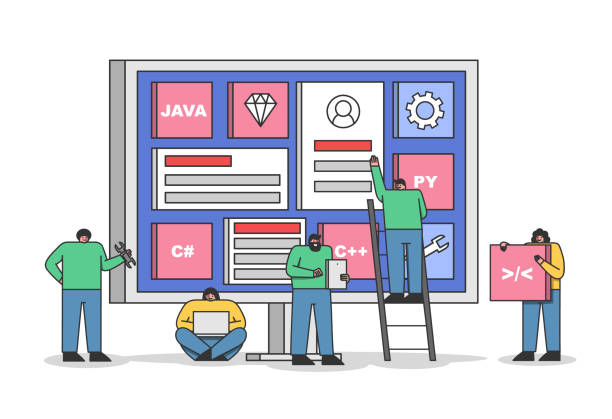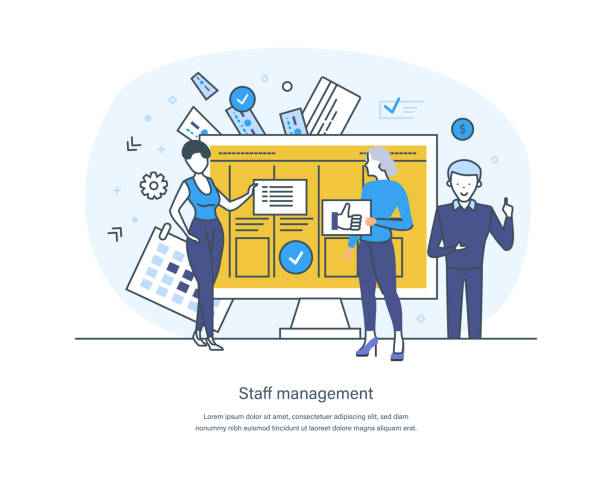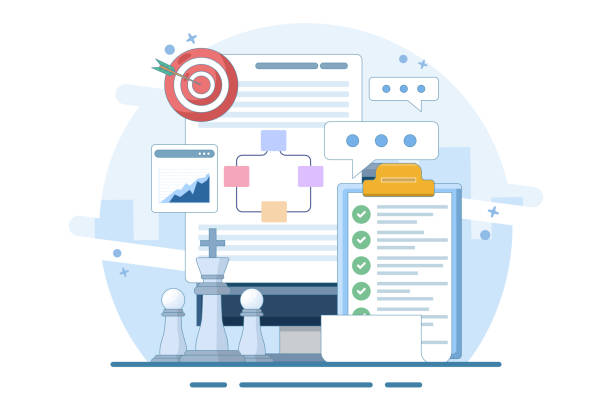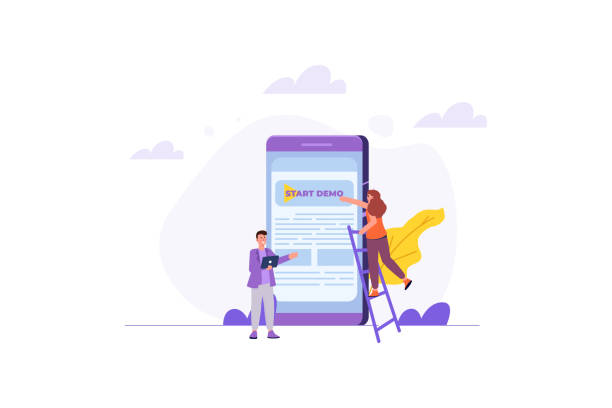An Introduction to the Importance of Secure Website Design and Its Fundamentals

In today’s digital world, where physical boundaries have lost their meaning and businesses are increasingly moving online, #secure_website_design is no longer a luxury choice but a vital necessity.
This importance extends not only to protecting sensitive user and company information but also to maintaining credibility and customer trust.
Websites, due to their public exposure and dynamic information exchange, become primary targets for cyberattacks.
Any flaw in secure website design can lead to data loss, service disruption, and even legal penalties.
An insecure website is not only a gateway for hackers but can also quickly erode customer trust and cause irreparable damage to your brand.
Therefore, understanding the fundamentals of web security and implementing proactive approaches in the early stages of website security is of paramount importance.
This explanatory and educational approach helps you take more robust steps to protect your digital assets by gaining a deeper understanding of existing risks.
For example, failing to use appropriate encryption protocols or not adhering to secure coding principles can open the door to attacks such as SQL injection or cross-site scripting (XSS), both of which can lead to unauthorized data access or website control.
Therefore, investing in secure website design is, in fact, an investment in the future and sustainability of your business.
Do you have an online store but your sales aren’t what you expected? Rasaweb solves your problem forever with professional e-commerce website design!
✅ Significant increase in conversion rates and sales
✅ Unparalleled user experience for your customers
⚡ Click to get free consultation with Rasaweb!
Familiarity with Common Website Security Threats

To achieve secure website design, one must first become familiar with the types of threats targeting websites.
This specialized and analytical understanding lays a solid foundation for defensive strategies.
One of the most common and destructive attacks is #SQL_injection, where attackers inject malicious SQL code into website input fields to gain access to the database.
This attack can lead to the theft, modification, or deletion of sensitive information.
Another attack is #Cross-Site_Scripting (XSS), where malicious JavaScript code is injected into legitimate web pages and then executed by visitors’ browsers.
These attacks can steal login credentials (cookies) or take control of a user’s session.
DDoS attacks (Distributed Denial of Service) also disrupt or severely slow down websites by sending a massive volume of fake traffic to the server, thereby disrupting legitimate user access.
Brute Force attacks involve repeated attempts to guess passwords or usernames and can compromise user accounts.
Ignoring these threats in the secure website design process can have irreversible consequences.
Furthermore, Zero-Day vulnerabilities, which are still unknown to developers, always pose a significant challenge and require a multi-layered defensive approach.
Therefore, continuous awareness and updating knowledge about these threats are an integral part of a comprehensive secure website design strategy.
The Role of SSL/TLS Security Protocols in Web Security

One of the most fundamental steps in secure website design is the implementation of SSL/TLS protocols.
These protocols not only #encrypt the data transmitted between the user’s browser and the website server but also enhance #website_trust by verifying the server’s identity.
SSL (Secure Sockets Layer) and its more advanced successor, TLS (Transport Layer Security), add a layer of security to web communications, preventing eavesdropping, tampering, and impersonation.
When a website uses HTTPS (the secure version of HTTP), it means it utilizes an SSL/TLS certificate.
These certificates are issued by Certificate Authorities (CAs) and confirm the genuine ownership of the domain.
The absence of these certificates not only leads to an “unsecure” message in browsers, which damages user trust, but can also negatively impact the website’s SEO ranking.
The choice of certificate type varies depending on business needs; from Domain Validation (DV) certificates for blogs to Organization Validation (OV) and Extended Validation (EV) certificates for e-commerce websites and financial websites that require the highest level of trust and identity verification.
Proper implementation of SSL/TLS is a crucial part of a secure website design strategy and user data protection.
This is a specialized guideline that every website should take seriously.
| Type of Certificate | Validation Level | Suitable Use Cases | Issuance Time |
|---|---|---|---|
| DV (Domain Validation) | Domain ownership validation | Blogs, personal sites, and small businesses | A few minutes |
| OV (Organization Validation) | Organization and domain validation | Business, government, and educational websites | A few days |
| EV (Extended Validation) | Full business identity validation | Banks, large e-commerce sites | A few weeks |
The Importance of Continuous Software and Plugin Updates

One of the biggest weaknesses in secure website design is neglecting #continuous_updates for software and plugins.
Hackers are constantly searching for new vulnerabilities in older software versions.
These vulnerabilities are typically found as security bugs in Content Management Systems (CMS) like WordPress, Joomla, and in their plugins and themes.
Developers release security patches as soon as these weaknesses are discovered.
Failure to apply these updates means leaving your website’s doors open to known attacks.
This is a common #educational mistake that many website administrators make.
The importance of this issue is so significant that many successful cyberattacks occur not due to the complexity of the attack, but due to negligence in simple updates.
This includes updating the CMS core, all plugins, themes, and even server software like PHP and databases.
A practical #guideline approach is to have a regular schedule for checking and applying updates, and to back up your website before any major update, so you can revert to the previous version if problems arise.
This not only helps maintain website security but often also includes performance improvements and new features.
Keeping all website components up-to-date is a crucial backbone for secure website design and its resilience against increasing threats.
Does your current e-commerce website design lead to lost customers and sales?
Rasaweb is your solution with modern and user-friendly e-commerce website designs!
✅ Significant increase in conversion rates and sales
✅ Strong branding and building customer trust
⚡ Get free e-commerce website design consultation from Rasaweb!
Password Management and Strong Authentication

Even the best secure website design will be ineffective if #password_management is weak.
Passwords are the first line of defense for accessing the website’s admin panel, database, and other critical systems.
Using weak, guessable, or reused passwords is one of the biggest common security mistakes.
A key guideline in this regard is to use complex and long passwords that combine uppercase and lowercase letters, numbers, and symbols.
Also, never use the same password for multiple accounts.
Password management tools can help you create and securely store strong passwords.
Furthermore, implementing #Two-Factor_Authentication (2FA) or Multi-Factor Authentication (MFA) is another vital step in strengthening security.
2FA provides an additional security layer beyond the password, meaning the user needs another verification factor (such as a code sent to a mobile phone or a fingerprint) in addition to the password to log in.
This prevents attackers from gaining access even if the password is stolen.
Two-factor authentication should be enabled for all important accounts, including website administration accounts, hosting, domains, and even associated emails.
This is a fundamental training for anyone involved with web security.
Secure website design is not just about coding; it also depends on the security behaviors of its users and administrators.
Regular Backups and Disaster Recovery Planning

No matter how precise you are in secure website design, there’s always a possibility of unforeseen incidents; from successful cyberattacks to human errors or hardware failures.
For this reason, #regular_data_backups and #disaster_recovery_planning are specialized and vital components of a comprehensive website security strategy.
Backing up is, in essence, an insurance policy for your data.
A secure website is one that can quickly return to normal with minimal data loss, even after a disaster.
This practical guidance includes creating backup copies of all website files (including core files, themes, plugins) and the database.
There are various backup methods, including full, incremental, and differential backups.
It’s important to store backup copies in a secure location separate from the main website server (e.g., in cloud storage, an external hard drive, or another server) so you can access them if the primary server is lost.
Backups should be performed automatically and regularly, and the data recovery process must be periodically tested to ensure its effectiveness.
This prevents serious problems during critical times and ensures that even after an attack or disaster, your website will be able to recover quickly.
Ultimately, backup is an integral component of the concept of sustainability and secure website design.
Web Application Firewalls (WAFs) and Intrusion Detection Systems

To complete secure website design, the use of advanced defensive tools such as #Web_Application_Firewalls (WAFs) and #Intrusion_Detection_Systems (IDS/IPS) is essential.
These tools provide additional layers of defense against cyberattacks.
A WAF acts as a filter between your website and the internet, analyzing incoming traffic and identifying and blocking malicious traffic.
WAFs can protect websites against attacks such as SQL injection, XSS, and malicious bot attacks.
They can be implemented at the network level, hosting level, or as cloud services.
On the other hand, IDS (Intrusion Detection System) are systems that detect suspicious activities or intrusion attempts and alert the system administrator, while IPS (Intrusion Prevention System), in addition to detection, are also capable of actively blocking threats.
This analytical and specialized approach allows you to protect your website against new and unknown threats by using behavioral patterns and known attack signatures.
The main difference between the two is the “prevention” capability: IDS only warns, while IPS acts.
Simultaneous implementation of WAF and IDS/IPS provides a #defense_in_depth strategy where multiple security layers work to cover each other’s weaknesses.
These tools are particularly vital for websites that have high traffic volumes or process sensitive information.
The use of these tools significantly enhances your secure website design capability and makes your website more resilient against complex attacks.
| Feature | Web Application Firewall (WAF) | Intrusion Detection/Prevention System (IDS/IPS) |
|---|---|---|
| Primary Focus | Protection of Layer 7 (Application) | Monitoring network and system traffic for intrusion patterns |
| Type of Traffic Analyzed | HTTP/HTTPS (Web requests and responses) | All network protocols |
| Functionality | Filtering and blocking specific web application attacks | Detecting (IDS) or preventing (IPS) suspicious activities |
| Examples of Targeted Attacks | SQL Injection, XSS, DDoS at the application layer | Port scanning, botnet attacks, abnormal network traffic |
Penetration Testing and Periodic Security Scans

Simply building a website and hoping it’s secure is not enough.
To ensure secure website design, performing #penetration_testing and #periodic_security_scans is a necessity.
This thought-provoking content actually points to the question: are you truly confident about your website’s security? Penetration Testing (or Pentest) is a controlled simulation of a real cyberattack performed by security experts with the aim of finding vulnerabilities before actual attackers discover them.
This specialized process involves attempting to penetrate systems, applications, and networks using methods similar to malicious hackers.
The results of these tests provide you with a detailed report of the website’s weaknesses so you can address them.
In addition to Pentest, performing periodic security scans (Vulnerability Scanning) is also of high importance.
These scans use automated tools to look for known vulnerabilities in the website, server, and its infrastructure.
Although security scans are not as comprehensive as Pentest, they can be performed regularly and at a lower cost, helping to quickly identify common issues.
These #proactive_security approaches help you always stay one step ahead of attackers and prevent security disasters.
Ignoring these tests severely increases your website’s security risk and can render all your efforts in secure website design ineffective.
Disappointed with your e-commerce site’s low conversion rate? Rasaweb transforms your e-commerce site into a powerful tool for attracting and converting customers!
✅ Significant increase in visitor-to-buyer conversion rate
✅ Unparalleled user experience to boost customer satisfaction and loyalty⚡ Get free consultation from Rasaweb!
Employee Training and Cybersecurity Awareness

Even the most advanced secure website design systems ultimately depend on the human factor.
#Employee_security_awareness and fostering a cybersecurity culture within an organization are the backbone of #comprehensive_security.
Many successful cyberattacks begin through social engineering and targeting employees with phishing or other tricks.
A careless employee can inadvertently become a gateway for attackers to penetrate internal systems or even your website’s administration panel.
This is an #educational and even #engaging part of security, as awareness can be delivered with real and interesting scenarios.
Regular training workshops on phishing threats, the importance of strong passwords, identifying suspicious emails, and safe online behaviors are essential.
Furthermore, a clear policy for reporting security incidents must be in place so that employees can report any suspicious activity without fear.
Promoting a security culture where everyone, from the CEO to the lowest levels, understands the importance of security and takes responsibility for it, is crucial.
This culture ensures that security is viewed as a shared responsibility, not just that of the IT team.
When employees are aware of the risks and have received the necessary training, the likelihood of human errors leading to intrusions significantly decreases.
Consequently, training and awareness programs are an indispensable and effective part of complementing secure website design and can make a significant difference in your organization’s overall security level.
Future Challenges in Secure Website Design and Novel Solutions

The world of cybersecurity is constantly evolving, and new challenges emerge every day.
To maintain secure website design in the future, one must not only counter current threats but also be prepared for #emerging_threats.
This section provides a #news and #analytical approach to examining the future horizons of web security.
One of the biggest future challenges is the emergence of Artificial Intelligence (AI)-driven attacks.
Attackers use AI to automate vulnerability detection processes, advanced phishing, and even create self-adapting malware.
In response, the solution also lies in using #security_AI to detect more complex attack patterns and react faster.
Internet of Things (IoT) security and the proliferation of attacks on web-connected devices are also a growing concern, as these devices can serve as entry points for larger attacks.
Blockchain and Web 3.0, despite their security potentials, introduce new challenges in secure web design.
Developing decentralized websites requires novel security approaches.
Future solutions include broader adoption of Zero Trust architectures that automatically distrust any user, even within the network, as well as the use of ever-evolving cryptographic methods, such as post-quantum cryptography, to combat quantum computing threats.
Furthermore, increased use of secure CDNs and cloud services with built-in security features will play a significant role in securing websites in the future.
For a sustainable secure website design, one must constantly be aware of the latest advancements and threats and adopt a dynamic and proactive approach.
Frequently Asked Questions
| Question | Answer |
|---|---|
| 1. What does secure website design mean? | Secure website design means creating a website that is resilient against cyberattacks and protects user and server information. |
| 2. Why is security important in website design? | To prevent data breaches, maintain user privacy, uphold user trust, and avoid financial and reputational losses. |
| 3. What are the most common web vulnerabilities? | SQL Injection, Cross-Site Scripting (XSS), Cross-Site Request Forgery (CSRF), Broken Authentication, and Security Misconfiguration. |
| 4. How can SQL injection be prevented? | By using Prepared Statements / Parameterized Queries, ORMs, and Input Validation. |
| 5. What is the role of HTTPS and SSL/TLS in website security? | HTTPS encrypts the communication between the user’s browser and the server using the SSL/TLS protocol, preventing eavesdropping and data tampering. |
| 6. What measures should be taken to prevent XSS attacks? | Input validation, output encoding to prevent malicious code execution, and using Content Security Policy (CSP). |
| 7. What does a strong password policy include? | Mandating the use of long passwords, a combination of uppercase and lowercase letters, numbers, and special characters, and preventing reuse. |
| 8. How does Two-Factor Authentication (2FA) contribute to security? | Even if a user’s password is compromised, the attacker cannot access the account without access to the second authentication factor (e.g., SMS code or app). |
| 9. What is a Web Application Firewall (WAF) and what is its use? | A WAF is a firewall that monitors and filters HTTP traffic between a web application and the Internet to prevent common web attacks like SQL injection and XSS. |
| 10. Why are regular updates for software and libraries important? | Updates often include security patches to fix discovered vulnerabilities. Failing to update can expose the site to new attacks. |
And other services of Rasa Web Advertising Agency in the field of advertising
Smart Website Development: A professional solution for improving SEO ranking with a focus on Google Ads management.
Smart Conversion Rate Optimization: Revolutionize click-through rate increase with marketing automation.
Smart Marketing Automation: A fast and efficient solution for customer behavior analysis with a focus on Google Ads management.
Smart Google Ads: A professional solution for user engagement with a focus on key page optimization.
Smart Custom Software: Revolutionize customer behavior analysis with Google Ads management.
And over a hundred other services in the fields of online advertising, advertising consultation, and organizational solutions
Online Advertising | Advertising Strategy | Advertorials
Sources
- Secure Website Design Guide
- Website Security Tips
- Best Secure Coding Practices
- Security Principles in Web Design
❓ Rasaweb Afarin Digital Marketing Agency, your reliable partner on the path to online growth!
For more information about our professional services, including WordPress website design, we are ready to take your business to the top.
📍 Tehran, Mirdamad Street, next to Bank Markazi, Southern Kazeroon Alley, Ramin Alley, Plaque 6




